The year 2020 has been historic for our country, as well as agriculture in general. Below are a few of the more noteworthy events from the past year that have affected the agriculture industry.
Trade War
The year opened on a positive note with the Phase One agreement signed by President Trump (2015 Land Investment Expo keynote speaker) and Chinese Vice Premier Liu He on January 15th. The deal ensured China's commitment to increasing purchases of U.S. agriculture products by $32 billion over two years, including $12.5 billion above the corresponding 2017 baseline of $24 billion in 2020 and $19.5 billion above the baseline in 2021.

President Trump and Vice Premier He Signing Phase 1 Trade Deal in Washington, DC
COVID-19
The U.S. declared a public health emergency on February 3rd after a new coronavirus was discovered that originated in Wuhan, China. Subsequent lockdowns and quarantines caused substantial disruption to agricultural supply chains as food spending drastically dropped in restaurants and institutional outlets and increased in retail stores. The disruptions spurred government ad hoc relief for farmers through two Coronavirus Food Assistance Programs (CFAP) and the Paycheck Protection Program (PPP). With over 320,000 deaths, relief is in sight in 2021 as vaccinations roll out across the nation.
Drought
One story that may have been lost in the major headlines was the drought that affected much of the Midwest and the Western United States. After a wet spring, minimal precipitation was received throughout the summer months. The hardest-hit crops were soybeans that need August rains for good yields. Unfortunately, the drought has persisted into the fall and early winter, leaving many farmers hoping for a wet spring and winter in 2021.
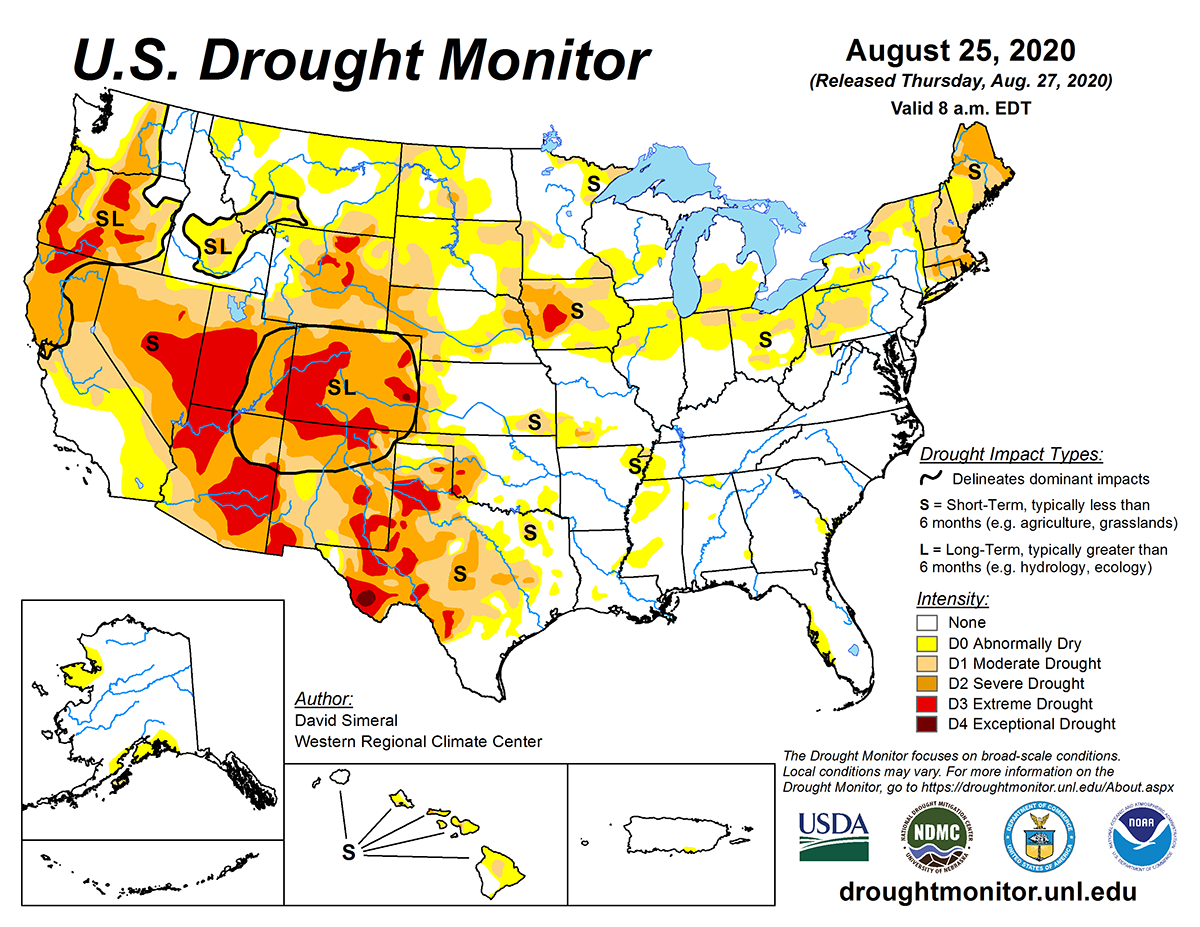
United States Drought Monitor, August 25th, 2020
Photo Credit: The National Drought Mitigation Center University of Nebraska-Lincoln
Derecho
On August 10th, a long-lasting line of thunderstorms with wind strength to rival hurricane forces — later labeled a derecho — battered over 700 miles of farmland across Iowa and the Midwest. The National Oceanic and Atmospheric Administration (NOAA) estimates the storm caused $7.5 billion in damage to an estimated 37.7 million acres of farmland across the Midwest and 14 million in Iowa alone. The NOAA data says the derecho is the most costly thunderstorm in U.S. history. Over 57 million bushels of commercial grain storage and tens of millions of bushels of on-farm storage were damaged.
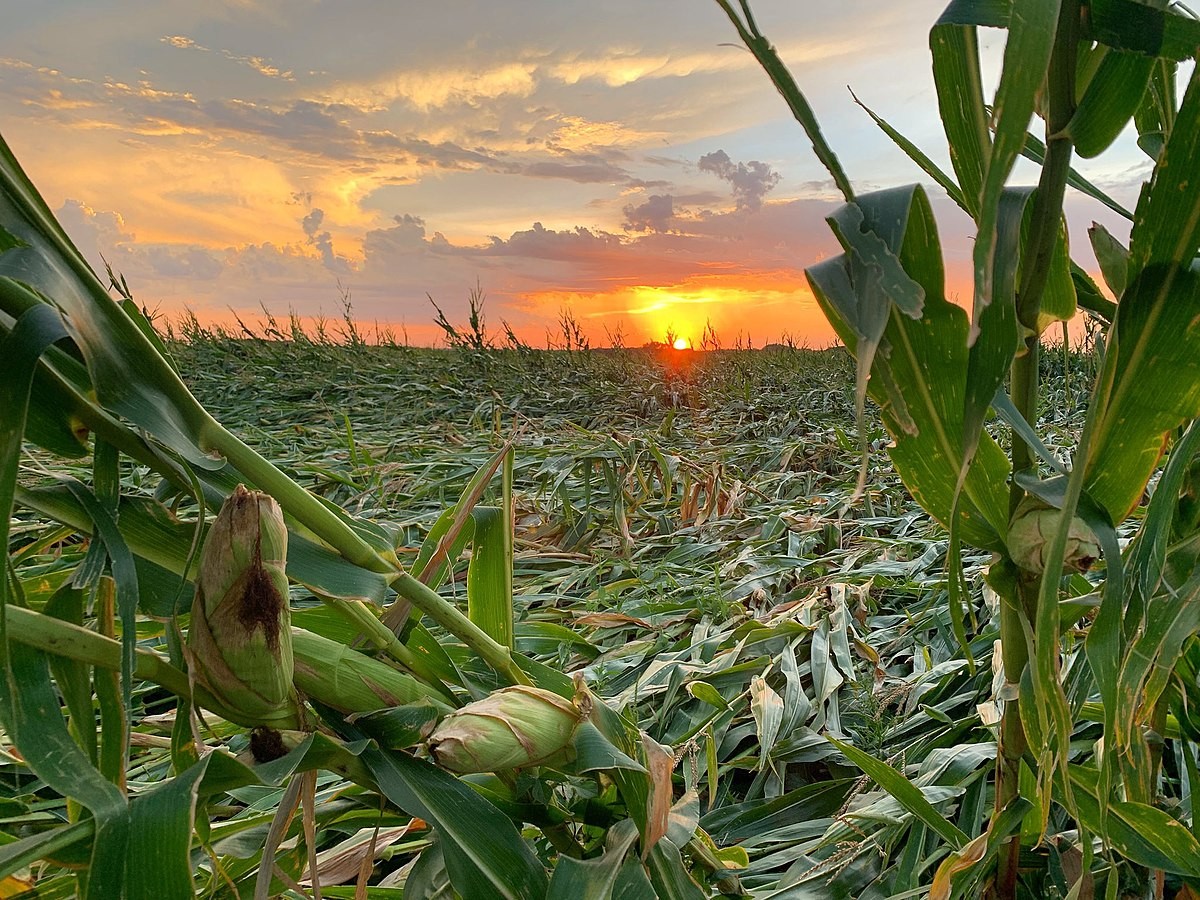
Significantly Damaged Cornfields from the Derecho
Photo Credit: Lisa Schmitz, National Weather Service, Des Moines, Iowa
Grain Prices
Due to dry weather in critical growing regions, grain yields were disappointing worldwide. Commodity prices were low through the first eight months of 2020 but have rebounded to profitable levels. Corn prices have increased by nearly $1 per bushel since August 2020, and soybeans have increased by almost $3 per bushel in the same period. This contradicts historical data for both corn and soybeans from 1974-2017. Over this 43-year period, commodity prices were lowest, on average, in the months of October. China proved to be a heavy buyer of U.S. grains and soybeans after importing little the first seven months of the year. As China works to rebuild its swine herd, the country is anticipated to have imported over 100 million tons of soybeans in 2020. To date, the country's swineherd has bounced back to 90% of its normal levels after an African swine fever outbreak. Soymeal demand is expected to remain strong.

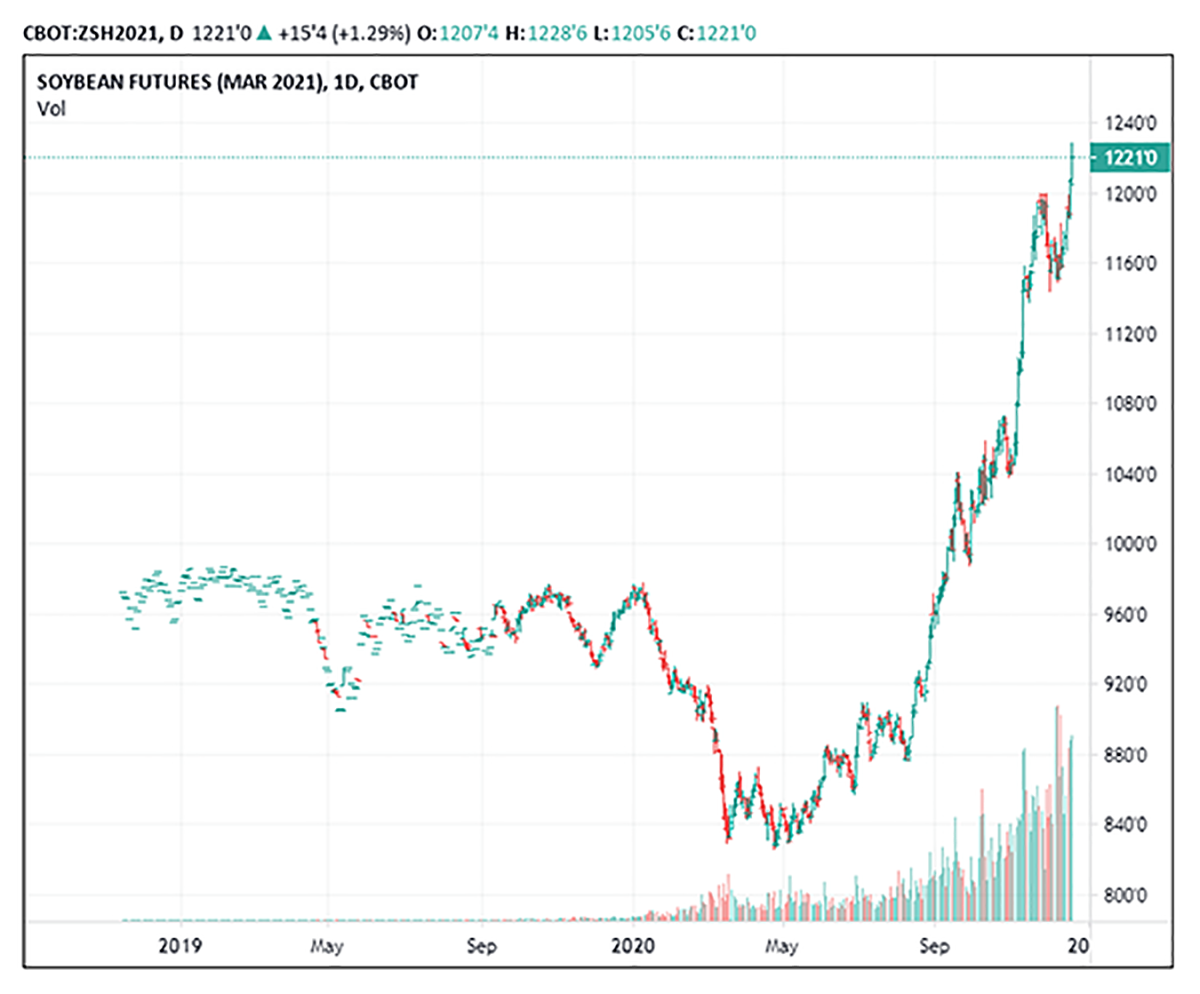
Chicago Board of Trade ZCH1 (Corn) and ZSH1 (Soybean) Futures Charts, December 22nd, 2020
Photo Credit: CME Group
Government Payments
Multiple sources of government payments helped make the year brighter for the bottom lines of many farm operators. The year's net farm income is projected to reach $120 billion, with $46 billion from direct federal support. Poor growing conditions in various areas triggered the Agricultural Risk Coverage (ARC) and Price Loss Coverage (PLC) program payments for some farms for the 2019 marketing year in 2020. In February, the third and final tranche of the 2019 Market Facilitation Program (MFP) payment to assist farmers suffering from damage due to unjustified trade retaliation by foreign nations made its way to farmers. With COVID-19 came the Coronavirus Food Assistance Program (CFAP) payments and CFAP 2. These programs were part of the massive stimulus plan Congress passed to infuse cash into the economy. Costs helped to prop up the agriculture sector devastated by market disruptions caused by measures to mitigate the deadly virus. Along with the CFAP programs, many farmers were eligible for the Paycheck Protection Program (PPP), a forgivable loan program designed to help keep employees working. The Wildfire and Hurricane Indemnity Program Plus (WHIP+) also paid funds to producers impacted by natural disasters in 2018 and 2019.
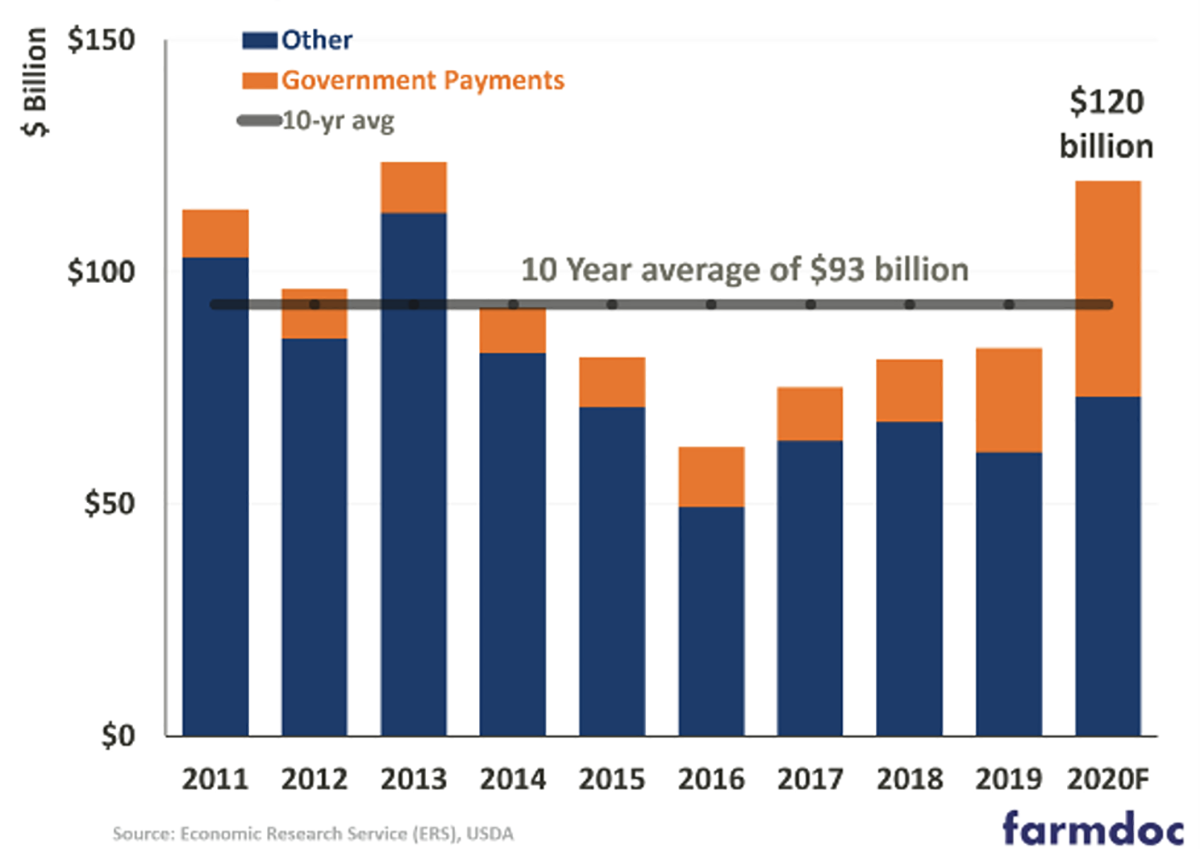
Farm Income and Perceptions Slide, Straining the Alphabet Soup: Post-election Farm Policy Outlook After Three Years of Ad Hoc Farm Payments, Illinois Farm Economic Summit, December 11th, 2020
Photo Credit: University of Illinois, Department of Agricultural and Consumer Economics
Interest Rates
Last March, in a bold move, the Federal Reserve took emergency action to support the economy during the pandemic by cutting its target interest rate near zero. Rates reached a level not seen since 2016. Th lowered cost of borrowing supported lower operating costs and stronger land values in the ag sector.
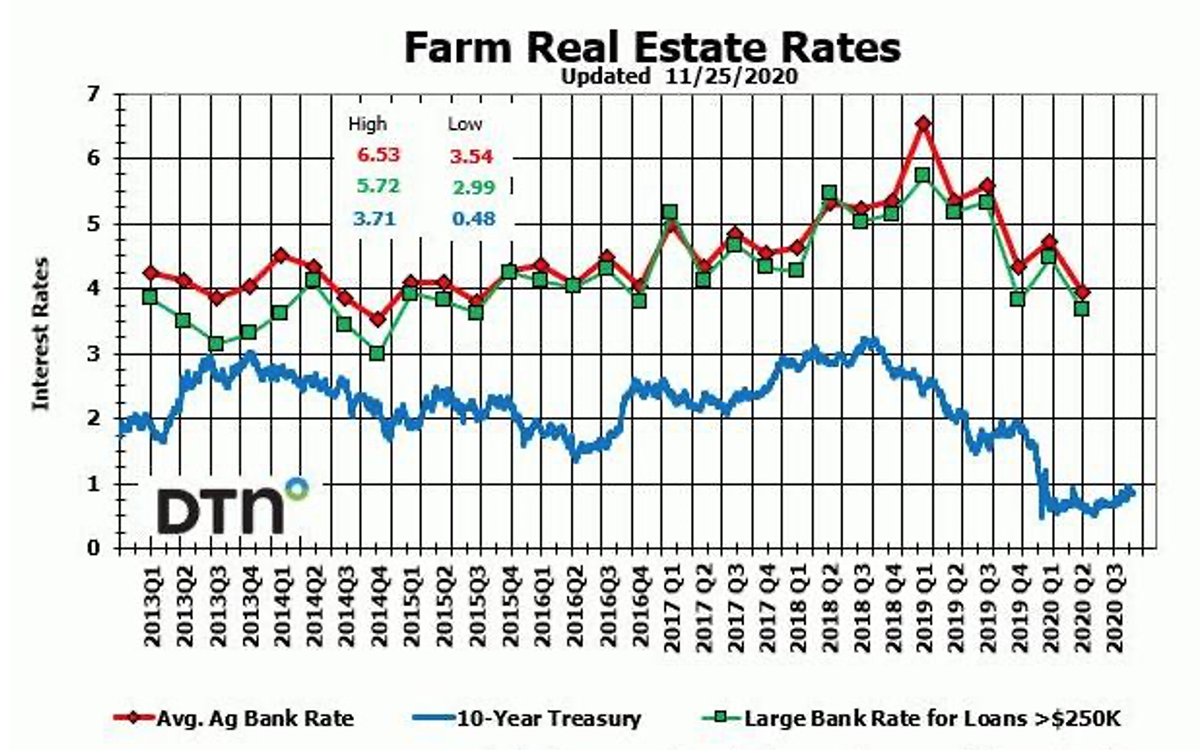
Ag Interest Rate Snapshot, November 25th, 2020
Photo Credit: DTN
Along with managing farms with challenges unique to the year, Peoples Company Land Management launched several new initiatives in 2020.
Leading Harvest
Leading Harvest is a coalition of public and private leaders from conservation, investment, agriculture, and research brought together to build a rigorous yet flexible sustainability standard. With such diverse soils, crops, and farming operations across the country, the freedom to innovate is vital to the standard. A third-party auditor ensures transparency assurance for the end-use consumer. Peoples Company enrolls all its managed farms in Leading Harvest. It is the only professional management company that provides the opportunity for individual landowners to receive the assurance of sustainability that Leading Harvest offers. Learn more at LeadingHarvest.org.
Direct Operations
Peoples Company launched a new Direct Operations platform in 2020. Emerging developments in farming technology and consumer preferences are providing opportunities for well-suited landowners to achieve premium returns. Through Peoples Company Direct Operations, landowners have full financial interest and control in the farming operations and crop production.
Nationwide Expansion
In 2020, Peoples Company grew its Land Management footprint into the Mississippi Delta and Pacific Northwest regions. Expanding land management services outside the Midwest furthers Peoples Company's strategy to become a full-service land resource for landowners and investors nationwide.
mAgma
mAgma offers investors the opportunity to gain access to farmland's superior investment qualities, including diversification, low volatility, inflation hedging, and premium returns while contributing to agriculture's sustainability and providing an equity source to landowners. The Land Management division of Peoples Company is excited to partner with mAgma following its launch in 2020. Learn more at mAgmaland.com.
DST Farms
Peoples Company Land Management also partnered with DST Farms in 2020, providing land management services for investors seeking the tax shelter for 1031 Exchanges that Delaware Statutory Trusts provide. The DST vehicle application to farmland investing is exciting as it allows investors to take direct ownership in an asset class historically requiring capital at a scale that is out of reach for many investors. Learn more at DSTFarms.com.
Peoples Company Land Management is based on the drive to understand the agriculture market to the best of our abilities and lead the industry as ambitious problem solvers who push the limit on thinking outside the box. We look forward to the opportunity to meet 2021's challenges and innovations. To learn more about how Peoples Company Land Management can help you reach your landowner goals, please visit PeoplesCompany.com or email LandManagement@PeoplesCompany.com.














